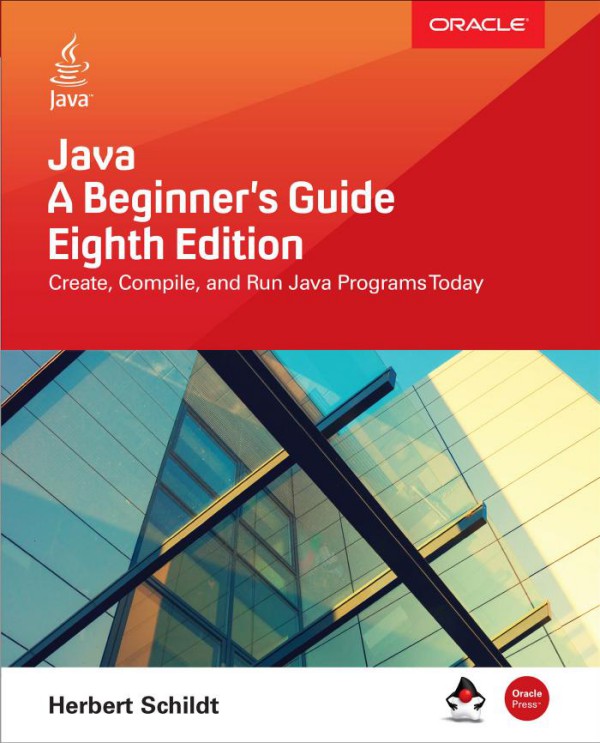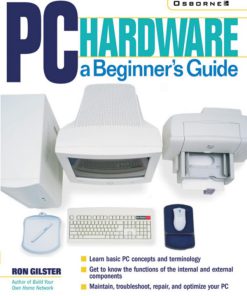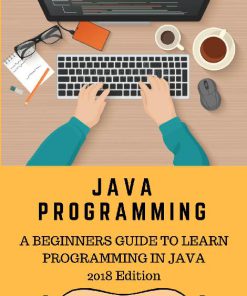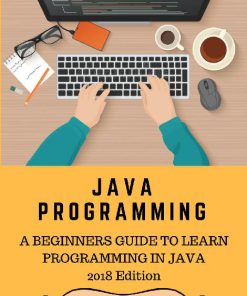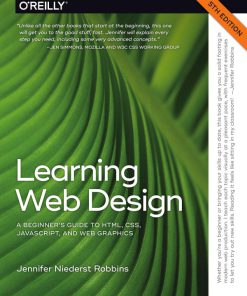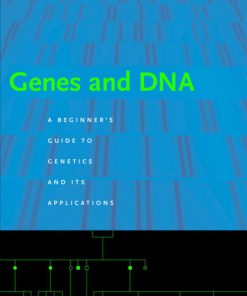Java A Beginner Guide 8th Edition by Herbert Schildt ISBN 1260440222 9781260440225
$50.00 Original price was: $50.00.$25.00Current price is: $25.00.
Authors:Herbert Schildt , Series:IT & Computer [469] , Tags:Computers; Internet; Web Programming , Author sort:Schildt, Herbert , Ids:Google; 9781260440218 , Languages:Languages:eng , Published:Published:Nov 2018 , Publisher:McGraw-Hill Education , Comments:Comments:Publisher’s Note: Products purchased from Third Party sellers are not guaranteed by the publisher for quality, authenticity, or access to any online entitlements included with the product.Up-to-Date, Essential Java Programming Skills—Made Easy!Fully updated for Java Platform, Standard Edition 11 (Java SE 11), Java: A Beginner’s Guide, Eighth Edition gets you started programming in Java right away. Best-selling programming author Herb Schildt begins with the basics, such as how to create, compile, and run a Java program. He then moves on to the keywords, syntax, and constructs that form the core of the Java language. The book also covers some of Java’s more advanced features, including multithreaded programming, generics, lambda expressions, modules, and Swing. As an added bonus, an introduction to JShell, Java’s interactive programming tool, is included. Best of all, it’s written in the clear, crisp, uncompromising style that has made Schildt the choice of millions worldwide.Designed for Easy Learning:•Key Skills and Concepts—Chapter-opening lists of specific skills covered in the chapter•Ask the Expert—Q&A sections filled with bonus information and helpful tips•Try This—Hands-on exercises that show you how to apply your skills•Self Tests—End-of-chapter quizzes to reinforce your skills•Annotated Syntax—Example code with commentary that describes the programming techniques being illustrated
Java A Beginner Guide 8th Edition by Herbert Schildt – Ebook PDF Instant Download/Delivery. 1260440222, 9781260440225
Full download Java A Beginner Guide 8th Edition after payment
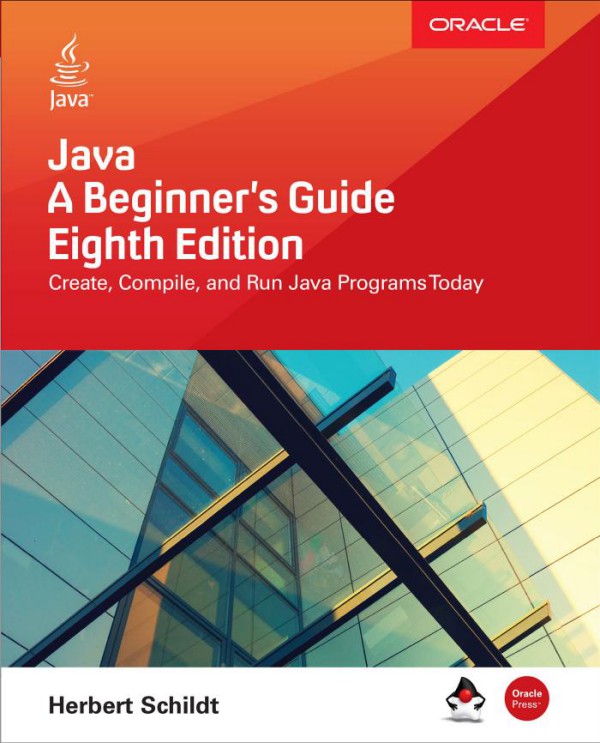
Product details:
ISBN 10: 1260440222
ISBN 13: 9781260440225
Author: Herbert Schildt
A practical introduction to Java programming—fully revised for long-term support release Java SE 11 Thoroughly updated for Java Platform Standard Edition 11, this hands-on resource shows, step by step, how to get started programming in Java from the very first chapter. Written by Java guru Herbert Schildt, the book starts with the basics, such as how to create, compile, and run a Java program. From there, you will learn essential Java keywords, syntax, and commands. Java: A Beginner’s Guide, Eighth Edition covers the basics and touches on advanced features, including multithreaded programming, generics, Lambda expressions, and Swing. Enumeration, modules, and interface methods are also clearly explained. This Oracle Press guide delivers the appropriate mix of theory and practical coding necessary to get you up and running developing Java applications in no time. •Clearly explains all of the new Java SE 11 features •Features self-tests, exercises, and downloadable code samples •Written by bestselling author and leading Java authority Herbert Schildt.
Java A Beginner Guide 8th Table of contents:
1 Java Fundamentals
The History and Philosophy of Java
The Origins of Java
Java’s Lineage: C and C++
How Java Impacted the Internet
Java’s Magic: The Bytecode
Moving Beyond Applets
A Faster Release Schedule
The Java Buzzwords
Object-Oriented Programming
Encapsulation
Polymorphism
Inheritance
The Java Development Kit
A First Simple Program
Entering the Program
Compiling the Program
The First Sample Program Line by Line
Handling Syntax Errors
A Second Simple Program
Another Data Type
Try This 1-1: Converting Gallons to Liters
Two Control Statements
The if Statement
The for Loop
Create Blocks of Code
Semicolons and Positioning
Indentation Practices
Try This 1-2: Improving the Gallons-to-Liters Converter
The Java Keywords
Identifiers in Java
The Java Class Libraries
Chapter 1 Self Test
2 Introducing Data Types and Operators
Why Data Types Are Important
Java’s Primitive Types
Integers
Floating-Point Types
Characters
The Boolean Type
Try This 2-1: How Far Away Is the Lightning?
Literals
Hexadecimal, Octal, and Binary Literals
Character Escape Sequences
String Literals
A Closer Look at Variables
Initializing a Variable
Dynamic Initialization
The Scope and Lifetime of Variables
Operators
Arithmetic Operators
Increment and Decrement
Relational and Logical Operators
Short-Circuit Logical Operators
The Assignment Operator
Shorthand Assignments
Type Conversion in Assignments
Casting Incompatible Types
Operator Precedence
Try This 2-2: Display a Truth Table for the Logical Operators
Expressions
Type Conversion in Expressions
Spacing and Parentheses
Chapter 2 Self Test
3 Program Control Statements
Input Characters from the Keyboard
The if Statement
Nested ifs
The if-else-if Ladder
The switch Statement
Nested switch Statements
Try This 3-1: Start Building a Java Help System
The for Loop
Some Variations on the for Loop
Missing Pieces
The Infinite Loop
Loops with No Body
Declaring Loop Control Variables Inside the for Loop
The Enhanced for Loop
The while Loop
The do-while Loop
Try This 3-2: Improve the Java Help System
Use break to Exit a Loop
Use break as a Form of goto
Use continue
Try This 3-3: Finish the Java Help System
Nested Loops
Chapter 3 Self Test
4 Introducing Classes, Objects, and Methods
Class Fundamentals
The General Form of a Class
Defining a Class
How Objects Are Created
Reference Variables and Assignment
Methods
Adding a Method to the Vehicle Class
Returning from a Method
Returning a Value
Using Parameters
Adding a Parameterized Method to Vehicle
Try This 4-1: Creating a Help Class
Constructors
Parameterized Constructors
Adding a Constructor to the Vehicle Class
The new Operator Revisited
Garbage Collection
The this Keyword
Chapter 4 Self Test
5 More Data Types and Operators
Arrays
One-Dimensional Arrays
Try This 5-1: Sorting an Array
Multidimensional Arrays
Two-Dimensional Arrays
Irregular Arrays
Arrays of Three or More Dimensions
Initializing Multidimensional Arrays
Alternative Array Declaration Syntax
Assigning Array References
Using the length Member
Try This 5-2: A Queue Class
The For-Each Style for Loop
Iterating Over Multidimensional Arrays
Applying the Enhanced for
Strings
Constructing Strings
Operating on Strings
Arrays of Strings
Strings Are Immutable
Using a String to Control a switch Statement
Using Command-Line Arguments
Using Type Inference with Local Variables
Local Variable Type Inference with Reference Types
Using Local Variable Type Inference in a for Loop
Some var Restrictions
The Bitwise Operators
The Bitwise AND, OR, XOR, and NOT Operators
The Shift Operators
Bitwise Shorthand Assignments
Try This 5-3: A ShowBits Class
The ? Operator
Chapter 5 Self Test
6 A Closer Look at Methods and Classes
Controlling Access to Class Members
Java’s Access Modifiers
Try This 6-1: Improving the Queue Class
Pass Objects to Methods
How Arguments Are Passed
Returning Objects
Method Overloading
Overloading Constructors
Try This 6-2: Overloading the Queue Constructor
Recursion
Understanding static
Static Blocks
Try This 6-3: The Quicksort
Introducing Nested and Inner Classes
Varargs: Variable-Length Arguments
Varargs Basics
Overloading Varargs Methods
Varargs and Ambiguity
Chapter 6 Self Test
7 Inheritance
Inheritance Basics
Member Access and Inheritance
Constructors and Inheritance
Using super to Call Superclass Constructors
Using super to Access Superclass Members
Try This 7-1: Extending the Vehicle Class
Creating a Multilevel Hierarchy
When Are Constructors Executed?
Superclass References and Subclass Objects
Method Overriding
Overridden Methods Support Polymorphism
Why Overridden Methods?
Applying Method Overriding to TwoDShape
Using Abstract Classes
Using final
final Prevents Overriding
final Prevents Inheritance
Using final with Data Members
The Object Class
Chapter 7 Self Test
8 Packages and Interfaces
Packages
Defining a Package
Finding Packages and CLASSPATH
A Short Package Example
Packages and Member Access
A Package Access Example
Understanding Protected Members
Importing Packages
Java’s Class Library Is Contained in Packages
Interfaces
Implementing Interfaces
Using Interface References
Try This 8-1: Creating a Queue Interface
Variables in Interfaces
Interfaces Can Be Extended
Default Interface Methods
Default Method Fundamentals
A More Practical Example of a Default Method
Multiple Inheritance Issues
Use static Methods in an Interface
Private Interface Methods
Final Thoughts on Packages and Interfaces
Chapter 8 Self Test
9 Exception Handling
The Exception Hierarchy
Exception Handling Fundamentals
Using try and catch
A Simple Exception Example
The Consequences of an Uncaught Exception
Exceptions Enable You to Handle Errors Gracefully
Using Multiple catch Statements
Catching Subclass Exceptions
Try Blocks Can Be Nested
Throwing an Exception
Rethrowing an Exception
A Closer Look at Throwable
Using finally
Using throws
Three Additional Exception Features
Java’s Built-in Exceptions
Creating Exception Subclasses
Try This 9-1: Adding Exceptions to the Queue Class
Chapter 9 Self Test
10 Using I/O
Java’s I/O Is Built upon Streams
Byte Streams and Character Streams
The Byte Stream Classes
The Character Stream Classes
The Predefined Streams
Using the Byte Streams
Reading Console Input
Writing Console Output
Reading and Writing Files Using Byte Streams
Inputting from a File
Writing to a File
Automatically Closing a File
Reading and Writing Binary Data
Try This 10-1: A File Comparison Utility
Random-Access Files
Using Java’s Character-Based Streams
Console Input Using Character Streams
Console Output Using Character Streams
File I/O Using Character Streams
Using a FileWriter
Using a FileReader
Using Java’s Type Wrappers to Convert Numeric Strings
Try This 10-2: Creating a Disk-Based Help System
Chapter 10 Self Test
11 Multithreaded Programming
Multithreading Fundamentals
The Thread Class and Runnable Interface
Creating a Thread
One Improvement and Two Simple Variations
Try This 11-1: Extending Thread
Creating Multiple Threads
Determining When a Thread Ends
Thread Priorities
Synchronization
Using Synchronized Methods
The synchronized Statement
Thread Communication Using notify( ), wait( ), and notifyAll( )
An Example That Uses wait( ) and notify( )
Suspending, Resuming, and Stopping Threads
Try This 11-2: Using the Main Thread
Chapter 11 Self Test
12 Enumerations, Autoboxing, Static Import, and Annotations
Enumerations
Enumeration Fundamentals
Java Enumerations Are Class Types
The values( ) and valueOf( ) Methods
Constructors, Methods, Instance Variables, and Enumerations
Two Important Restrictions
Enumerations Inherit Enum
Try This 12-1: A Computer-Controlled Traffic Light
Autoboxing
Type Wrappers
Autoboxing Fundamentals
Autoboxing and Methods
Autoboxing/Unboxing Occurs in Expressions
A Word of Warning
Static Import
Annotations (Metadata)
Chapter 12 Self Test
13 Generics
Generics Fundamentals
A Simple Generics Example
Generics Work Only with Reference Types
Generic Types Differ Based on Their Type Arguments
A Generic Class with Two Type Parameters
The General Form of a Generic Class
Bounded Types
Using Wildcard Arguments
Bounded Wildcards
Generic Methods
Generic Constructors
Generic Interfaces
Try This 13-1: Create a Generic Queue
Raw Types and Legacy Code
Type Inference with the Diamond Operator
Local Variable Type Inference and Generics
Erasure
Ambiguity Errors
Some Generic Restrictions
Type Parameters Can’t Be Instantiated
Restrictions on Static Members
Generic Array Restrictions
Generic Exception Restriction
Continuing Your Study of Generics
Chapter 13 Self Test
14 Lambda Expressions and Method References
Introducing Lambda Expressions
Lambda Expression Fundamentals
Functional Interfaces
Lambda Expressions in Action
Block Lambda Expressions
Generic Functional Interfaces
Try This 14-1: Pass a Lambda Expression as an Argument
Lambda Expressions and Variable Capture
Throw an Exception from Within a Lambda Expression
Method References
Method References to static Methods
Method References to Instance Methods
Constructor References
Predefined Functional Interfaces
Chapter 14 Self Test
15 Modules
Module Basics
A Simple Module Example
Compile and Run the First Module Example
A Closer Look at requires and exports
java.base and the Platform Modules
Legacy Code and the Unnamed Module
Exporting to a Specific Module
Using requires transitive
Try This 15-1: Experiment with requires transitive
Use Services
Service and Service Provider Basics
The Service-Based Keywords
A Module-Based Service Example
Additional Module Features
Open Modules
The opens Statement
requires static
Continuing Your Study of Modules
Chapter 15 Self Test
16 Introducing Swing
The Origins and Design Philosophy of Swing
Components and Containers
Components
Containers
The Top-Level Container Panes
Layout Managers
A First Simple Swing Program
The First Swing Example Line by Line
Swing Event Handling
Events
Event Sources
Event Listeners
Event Classes and Listener Interfaces
Use JButton
Work with JTextField
Create a JCheckBox
Work with JList
Try This 16-1: A Swing-Based File Comparison Utility
Use Anonymous Inner Classes or Lambda Expressions to Handle Events
Chapter 16 Self Test
A Answers to Self Tests
Chapter 1: Java Fundamentals
Chapter 2: Introducing Data Types and Operators
Chapter 3: Program Control Statements
Chapter 4: Introducing Classes, Objects, and Methods
Chapter 5: More Data Types and Operators
Chapter 6: A Closer Look at Methods and Classes
Chapter 7: Inheritance
Chapter 8: Packages and Interfaces
Chapter 9: Exception Handling
Chapter 10: Using I/O
Chapter 11: Multithreaded Programming
Chapter 12: Enumerations, Autoboxing, Static Import, and Annotations
Chapter 13: Generics
Chapter 14: Lambda Expressions and Method References
Chapter 15: Modules
Chapter 16: Introducing Swing
B Using Java’s Documentation Comments
The javadoc Tags
@author
{@code}
@deprecated
{@docRoot}
@exception
@hidden
{@index}
{@inheritDoc}
{@link}
{@linkplain}
{@literal}
@param
@provides
@return
@see
@since
{@summary}
@throws
@uses
{@value}
@version
The General Form of a Documentation Comment
What javadoc Outputs
An Example That Uses Documentation Comments
C Compile and Run Simple Single-File Programs in One Step
D Introducing JShell
JShell Basics
List, Edit, and Rerun Code
Add a Method
Create a Class
Use an Interface
Evaluate Expressions and Use Built-in Variables
Importing Packages
Exceptions
Some More JShell Commands
Exploring JShell Further
E More Java Keywords
The transient and volatile Modifiers
instanceof
strictfp
assert
People also search for Java A Beginner Guide 8th:
core java, volume i: fundamentals
borrow core java volume i fundamentals
core java volume i fundamentals 13th edition
core java volume i fundamentals 12th edition
core java volume i fundamentals 13th edition download

